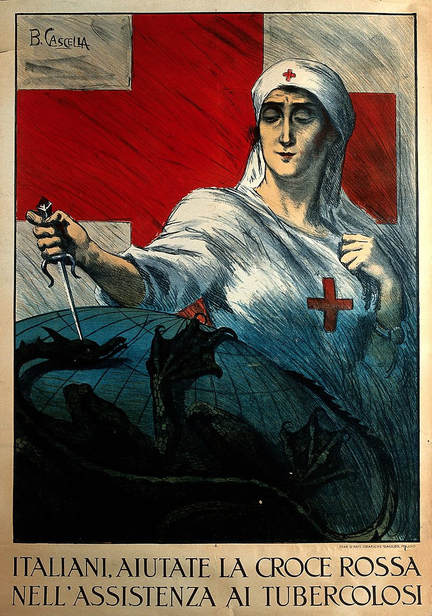Tuberkulose-Heilstätten/Tuberculosis sanatoria
|
Beelitz Heilstätten
Heilstätten am See
Piano Sanatorium
Kinderkrankenhaus im Wald
Knappschaftsheilstätte
Klinik Verwunschener Wald
Sanatorio al Monte
|
Krankenhaus im Park
Das Geistersanatorium
Johanniterheilstätte
Albrechtshaus
Volksheilstätte Amalie
Ospedale Grande
|
Preventorio Rocco
Heilstätten im Wald
Harzwaldklinik
Sanatorium Waldeck
Waldklinik
Sanatorium Zauberwald
|
Die "romantische" Krankheit - The "romantic" disease
“[…] it was the fashion to suffer from the lungs; everybody was consumptive, poets especially; it was good form to spit blood after each emotion that was at all sensational, and to die before the age of thirty […].”
(Alexandre Dumas, "Memoirs")
“I should like to die from consumption.”
(Lord Byron)
(Alexandre Dumas, "Memoirs")
“I should like to die from consumption.”
(Lord Byron)
Die Schwindsucht (Lungentuberkulose, Morbus Koch oder auch kurz TBC) ist eine durch Bakterien verursachte, auch heute noch weit verbreite, Infektionskrankheit. Das Mykobakterium tuberculosis wurde erstmals 1882 von Robert Koch entdeckt und beschrieben. Um 1900 war sie eine der häufigsten Todesursachen überhaupt. Der Lungentuberkulose, die auch auf andere Körperteile übergreifen konnte, vermochte anfangs nur durch den Bau von Lungensanatorien Einhalt geboten zu werden. Die Ärzte setzten hauptsächlich auf Schonkost und Liegekuren an der frischen Luft. Als besonders heilsam galt frische Bergluft oder auch ein mediterranes Klima.
Meist waren diese Lungenheilstätten anfänglich ausschließlich der Oberschicht vorbehalten, später jedoch bedachte man auch zunehmend die arme Bevölkerung, da die TBC zur Volksseuche geworden war, die sich vor allem in der Arbeiterschicht rasend verbreitete. Geschuldet war dies im Allgemeinen den vorherrschenden katastrophalen hygienischen Bedingungen um die Jahrhundertwende (Stichwort Trockenwohnen).
Der Aspekt der zur Volksseuche mutierten Krankheit und die Tatsache, dass auch viele junge Leute und Künstler, die oftmals zur armen Bevölkerung zählten, erkrankten, führte auch zu einer vermehrten Thematisierung in der Kunst. Ein bekanntes Beispiel aus der Literatur stellt Thomas Manns "Der Zauberberg" dar. Aufgrund dieser massenhaften Erkrankungen und eben dieser speziellen Personengruppen wurde die TBC zeitweise auch als "romantische Krankheit" bezeichnet. Die Künste im Allgemeinen trugen, besonders durch die Verklärung der Krankheit, zu diesem Bild bei. Letztlich war dies aber sicherlich schlichtweg ein Versuch mit dem Tod und Elend der Zeit umzugehen. Weniger beschönigende und romantisierende Bezeichnungen der Realität waren jedoch auch geläufig. Etwa sprach man dann eher von der weißen Pest/dem weißen Tod oder davon, die Motten zu haben.
Nach der Entdeckung des Penicillins (1928) durch Alexander Fleming wurden die Lungenheilstätten nach und nach überflüssig.
The pulmonary tuberculosis (also consumption, abbrev.: TB) is a bacterial contagious disease which is still existing today. The Mycobacterium tuberculosis was first discovered and described by Robert Koch in 1882. The TB was one of the most common causes of death around the turn of the century. The lung tuberculosis that sometimes spread to other body parts as well could only be controlled by the building of lung sanatoriums. In the beginning they had mainly been provided for members of the upper class only. Yet, due to the rampant spreading throughout all members of society and especially due to the spreading among people of poverty, the sanatoriums opened their doors for members of the working class, too.
The doctors back then mostly tried to heal tuberculosis with a special diet and rest cures in the open air. Above all, fresh mountain air and the Mediterranean climate were considered especially healthy.
As the TB affected mostly the poor and the young including many artists (which often belonged to the poor population), the disease became often referred to as "romantic disease." A very famous literary piece that deals with the topic of TB and living in a lung sanatorium is Thomas Mann´s "Der Zauberberg" ("The Magic Mountain"). It was the arts that especially shaped the picture of a "romantic" disease. For sure, also as an attempt to find somewhat sense in the death and misery of that time. But there were also less romanticizing terms common like the White Plague.
After the discovery of penicillin (in 1928) by Alexander Fleming lung sanatoria became gradually redundant.
Meist waren diese Lungenheilstätten anfänglich ausschließlich der Oberschicht vorbehalten, später jedoch bedachte man auch zunehmend die arme Bevölkerung, da die TBC zur Volksseuche geworden war, die sich vor allem in der Arbeiterschicht rasend verbreitete. Geschuldet war dies im Allgemeinen den vorherrschenden katastrophalen hygienischen Bedingungen um die Jahrhundertwende (Stichwort Trockenwohnen).
Der Aspekt der zur Volksseuche mutierten Krankheit und die Tatsache, dass auch viele junge Leute und Künstler, die oftmals zur armen Bevölkerung zählten, erkrankten, führte auch zu einer vermehrten Thematisierung in der Kunst. Ein bekanntes Beispiel aus der Literatur stellt Thomas Manns "Der Zauberberg" dar. Aufgrund dieser massenhaften Erkrankungen und eben dieser speziellen Personengruppen wurde die TBC zeitweise auch als "romantische Krankheit" bezeichnet. Die Künste im Allgemeinen trugen, besonders durch die Verklärung der Krankheit, zu diesem Bild bei. Letztlich war dies aber sicherlich schlichtweg ein Versuch mit dem Tod und Elend der Zeit umzugehen. Weniger beschönigende und romantisierende Bezeichnungen der Realität waren jedoch auch geläufig. Etwa sprach man dann eher von der weißen Pest/dem weißen Tod oder davon, die Motten zu haben.
Nach der Entdeckung des Penicillins (1928) durch Alexander Fleming wurden die Lungenheilstätten nach und nach überflüssig.
The pulmonary tuberculosis (also consumption, abbrev.: TB) is a bacterial contagious disease which is still existing today. The Mycobacterium tuberculosis was first discovered and described by Robert Koch in 1882. The TB was one of the most common causes of death around the turn of the century. The lung tuberculosis that sometimes spread to other body parts as well could only be controlled by the building of lung sanatoriums. In the beginning they had mainly been provided for members of the upper class only. Yet, due to the rampant spreading throughout all members of society and especially due to the spreading among people of poverty, the sanatoriums opened their doors for members of the working class, too.
The doctors back then mostly tried to heal tuberculosis with a special diet and rest cures in the open air. Above all, fresh mountain air and the Mediterranean climate were considered especially healthy.
As the TB affected mostly the poor and the young including many artists (which often belonged to the poor population), the disease became often referred to as "romantic disease." A very famous literary piece that deals with the topic of TB and living in a lung sanatorium is Thomas Mann´s "Der Zauberberg" ("The Magic Mountain"). It was the arts that especially shaped the picture of a "romantic" disease. For sure, also as an attempt to find somewhat sense in the death and misery of that time. But there were also less romanticizing terms common like the White Plague.
After the discovery of penicillin (in 1928) by Alexander Fleming lung sanatoria became gradually redundant.
Das kranke Kind - Det syke barn (Edvard Munch)
(Edvard Munch - http://samling.nasjonalmuseet.no/no/object/NG.M.00839 Nasjonalmuseet / Høstland, Børre - gemeinfrei)
Weiterführendes - Further reading:
History of Tuberculosis (wikipedia - ENG)
http://en.wikipedia.org/wiki/History_of_tuberculosis
History of Tuberculosis (wikipedia - ENG)
http://en.wikipedia.org/wiki/History_of_tuberculosis
Seuchengeschichte, TBC - History of TBC (GER)
(gemeinfrei - in the public domain)






















